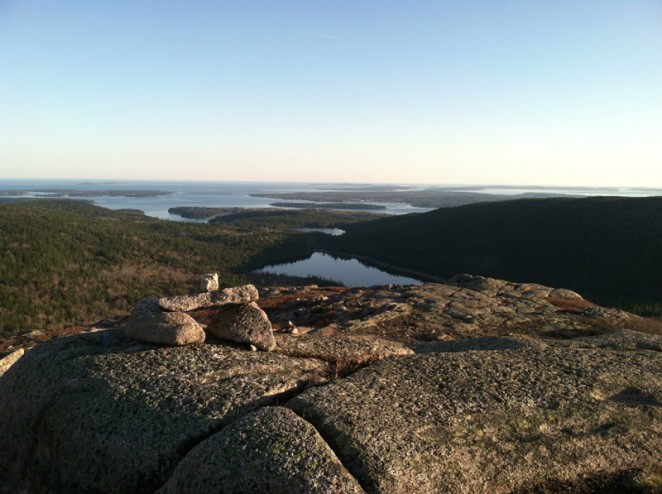 Hiking is an obsession for me, an integral part of my life. And, despite my best efforts to integrate it into my children's lives my pleas for Saturday afternoon family hikes are usually met with groans of protest. Someday perhaps they'll recognize the same deeper connection to the land that I've found so satisfying through hiking too.
Living near Acadia National Park allows me access to challenging and uber-scenic hiking locations. If you've never visited Acadia, the bulk of the park is located just past the mid-coast area of Maine on Mount Desert Island. The island is a glacier worn grouping of granite domes perched at the edge of the Atlantic ocean. Here the raw granite meets the sea and is cloaked by spruce forest, fog and salty air. People carve out their lives here by understanding and exploiting these natural resources and the people who come to visit. Artists, fisherman, scientists, cooks, potters, boat builders, we're all here charting out our lives often against, but more often in concert with nature.
Hiking is an obsession for me, an integral part of my life. And, despite my best efforts to integrate it into my children's lives my pleas for Saturday afternoon family hikes are usually met with groans of protest. Someday perhaps they'll recognize the same deeper connection to the land that I've found so satisfying through hiking too.
Living near Acadia National Park allows me access to challenging and uber-scenic hiking locations. If you've never visited Acadia, the bulk of the park is located just past the mid-coast area of Maine on Mount Desert Island. The island is a glacier worn grouping of granite domes perched at the edge of the Atlantic ocean. Here the raw granite meets the sea and is cloaked by spruce forest, fog and salty air. People carve out their lives here by understanding and exploiting these natural resources and the people who come to visit. Artists, fisherman, scientists, cooks, potters, boat builders, we're all here charting out our lives often against, but more often in concert with nature.
The Bates Cairn
Aside from the physical activity and mental awareness hiking brings me, one of the things I find most rewarding about hiking is a deeper understanding of the world around me. I'm fascinated with the intersection of man's machine and nature. These are often forces which drive my architectural work, integrating buildings into their surrounding context, marveling at their weathering with time. This metaphorical tug-of-war is present everywhere, including the trails of Acadia.
If you've ever hiked above the treeline on a large mountain, you're familiar with cairns. Rock piles crafted by man to mark trails and pathways. They're necessary in locations subject to poor visibility and can mean the difference between a cold night spent on the mountain or a warm night off of it. If you hike a lot, like me, you may reach a point where they're like trees...they're a part of the landscape and you pay little attention to them.
I can't count the times I've walked between these simple landmarks, thinking of them as nothing more than markers along a path, but so often relying on them to return me to less foggy elevations. While reading a favorite column of mine in the Bangor Daily News called, 1-Minute Hike, I was surprised to hear reference to these markers as Bates Cairns. Designed by Waldron Bates in the early 1900s as unique trail markers. Each cairn is comprised of two support posts and one lintel spanning the posts capped by a pointer rock paralleling the trail. It's precisely Laugier's primitive hut and I think it's simply genius. The open topography and granite precipices here can be visually flat in poor weather and fog. It's easy to lose your way, but the degree to which these constructions stand out is remarkable. The simple act of creating a shadow beneath the lintel helps identify these as path points. And, their geometry is distinct and separate from a standard conical cairn. Which, in this landscape, would only work to camouflage them among myriad other rock formations.
Because of the efforts of Waldron Bates, I'm not only a thankful patron of all of the path making he accomplished during his lifetime but also a little more appreciative of his weather beaten constructs.
New Trails
This week marks the first full week of me bootstrapping my own, newly minted, design firm. The past seven days have been an emotional ride. Having to leave a place that provided me with many opportunities, fulfilling work, professional mentoring and some really good friends was a very difficult thing for me. Traveling new trails is difficult work but it's often the most rewarding. You're not sure of the destination, how long it will take to arrive, or if there's even a somewhere to go. Way finding has suddenly become a much more crucial activity for me and I'm searching in earnest for the next cairn.

